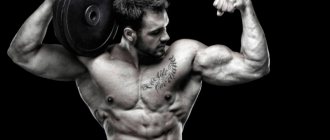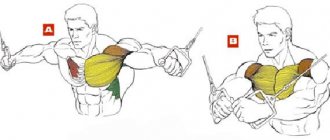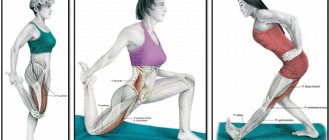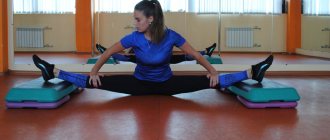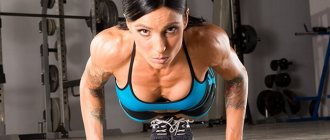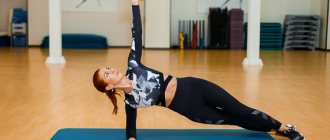A crossover is a special simulator, which is a structure of two frames and two blocks: lower and upper. It is used to work the chest, buttocks, and back. Exercises suitable for crossover are varied and numerous. Using only this simulator in training, you can see pleasant changes in your figure in a fairly short period.
Benefits of Crossover Exercises
The exercises that are performed on this simulator are quite specific. For a beginner who is not used to training, it is often difficult to navigate. But once you understand the technology and its features, you can get a lot of advantages:
- Work of several muscle groups when performing one exercise. When performing crossover exercises, you cannot do with one muscle group while isolating the others. For example, if the muscles of the arms and biceps are being worked, in most cases the pectoral muscles will be involved.
- Crossover exercises for men allow you to work out and sharpen the shape of lagging muscles in isolation, making them more pronounced.
- The specificity of the design is such that when performing any exercise, maximum stretching of the working muscle will occur.
- Using a weight that is much lighter than in isolated exercises (press, deadlift, etc.). This feature makes the crossover a less dangerous exercise machine.
- Great variability in use. There is a huge variety of exercises for all muscle groups. There are exercises that beginner athletes can do, and there are exercises for seasoned professionals.
Using a crossover simulator, exercises can be performed on the pectoral muscles, gluteal muscles, back, and biceps.
Crossover trainer – what is it?
This design is a block frame for strength training, with which you can specifically develop different muscle groups. The unit is popular and is often placed in large halls, but it can also be purchased for home use. On it, the athlete performs a variety of exercises by tensioning a cable attached to a load. The crossover trainer is available in the following types:
- block stand;
- exercise machine with blocks on free weights.
- angular;
- with double frame;
Currently, the crossover simulator is divided into the following categories:
- Professional. They are distinguished by great reliability, durability, silent operation and smooth operation of the mechanisms.
- Homemade. They are compact, lightweight and foldable. Functionality is ensured by the use of removable elements.
- Fitness station. They make it possible to effectively work out different muscle groups. The design is more stable and reliable than the home version.
What does a crossover trainer consist of?
The desire to play sports and at the same time load all muscle groups is a reason to purchase this device. The universal simulator consists of two frames, each of which has a lower and an upper block, located opposite each other and interconnected by an upper jumper. In addition, there is a crossbar for hanging and pulling up and various devices with which you can diversify the training process.
Crossover exercises for the pectoral muscles
The main technique in the crossover to the chest is to bring the arms together. Provides complete treatment of the entire chest area. Due to the work of the joints, the muscular component of the chest works at full strength.
The specifics of the exercise are as follows:
- Select the desired load (weight). It is always recommended to start with minimal loads. It should be the same on both sides of the frame.
- We lean forward a little, feet shoulder-width apart, knees in a squat. The leg can be placed forward for better fixation of the body. In this case, the right and left legs will need to be alternated during the exercise.
- We take the handrails of the upper blocks with our hands, the back is straight, the elbow joints are bent.
- Let's take a breath. As you exhale, maintaining the position of your arms and back, bring your arms together at hip level. We fix the position of the body for a few seconds.
- We return to the original position.
It is necessary to perform 3-4 approaches of 12-15 times.
If our main goal is to work the upper pectoral muscles, then this exercise should be performed from the lower block.
- The torso is in a standing position, arms are moved slightly back, elbows are bent. The handles are attached to the lower links.
- As you inhale, raise your arms and bring them together in front of you at stomach level.
- We fix the position and hold it for several seconds. It is important to feel the tension in the back muscles to be sure of the correct technique.
- Then we return to the starting position.
It is important to control the exercise technique and avoid transferring the load to the hands and forearms.
These exercises can and should be combined and alternated in one workout. This will ensure maximum development of the back muscles.
Benefits and contraindications
Before moving on to the story about the technique of performing the exercise, we will briefly describe what advantages and benefits it gives the athlete, as well as to whom its implementation is contraindicated and for what reasons.
Benefits of exercise
With the help of hand movements in a crossover, you can make a huge leap in the development of the pectoral muscles. It is ideal for learning how to “turn on” them correctly, since the work is isolated, the shoulders and triceps are practically excluded from the movement, which cannot be said about other chest exercises.
As a rule, crossover exercises are placed towards the end of the chest workout to achieve maximum blood flow. The work is carried out in a wide range of repetitions - from 12 and above. The working weight is not particularly important; it is much more important to feel the stretch and contraction of the pectoral muscles.
© zamuruev — stock.adobe.com
Contraindications for performing the exercise
It is not recommended to perform crossover exercises while lying down for athletes who have the following diseases:
- brachial nerve neuritis;
- tendobursitis;
- tendinitis.
Stretching the pectoral muscles too much at the bottom will overstrain the shoulder joints and ligaments, and chronic pain will be felt much more intensely. This applies less to the classic crossover while standing through the upper blocks, but you still need to be careful not to use excessively heavy working weights.
Beginners are not recommended to crossover their arms through lower blocks. This is a very difficult exercise from a technical point of view, requiring an unreal neuromuscular connection. Newbies simply don't have this. Develop your upper chest better with incline presses and flyes, and when you notice an increase in muscle mass, you can smoothly begin performing crossover crossover exercises.
Exercises for the buttocks
Leg swings are perfect for properly working out the gluteal muscle. This crossover exercise is suitable for girls and does not require any special physical training. The main thing is to follow the technique and monitor the position of your back.
- We put on the cuff with fastening and fix the load cable.
- We hold the support block with our hands, tilt our back slightly forward, and fix our torso.
- We work with each leg in turn.
- We move the leg back at an angle of about 20% to isolate the back and work only the gluteal muscle.
- Maintaining the range of motion, we fix the leg in the upper position for a few seconds, after which we return it.
This crossover exercise for women can be performed from a kneeling position. For convenience, it is better for girls to use a bench.
- We install the bench next to the frame. We fix the cuffs and cables on the leg.
- We fix the body in a kneeling position, supported by straight arms, facing the frame.
- From this position we perform upward swings with a wide amplitude for maximum pumping of the gluteal muscle.
- We perform several approaches alternating legs.
When performing the exercise, men and women need to avoid excessive arching in the lower back, and also monitor the static position of the body on the bench.
We perform 3 sets of 12 swings on each leg.
Don't forget to do a little muscle stretching after each exercise!
Mixing on an incline bench
In terms of starting position and execution, the movement is completely identical to the previous one.
The point of using an incline bench is to use additional amplitude to stretch the muscle. In all technical variants, pushing the body, jerking the arms, and changing the angle of the elbow, knee, hip and shoulder joints are prohibited. The movement is performed with little resistance, the goal is to stretch the muscles as much as possible and statically tense them.
Crossover back exercises
An effective exercise is a pullover in the upper block of a crossover (exercises from the “traction” category). Involves all back muscles with emphasis on the latissimus. This exercise helps to create a beautiful, muscular and proportional back.
- We use a handle or bar for crossover rows.
- Facing the frame, we take the handle in the position from above. Arms are straightened. Legs in a light squat position. We move the body back.
- Let's take a breath. As you exhale, using only the back muscles, lower the bar until it contacts the hips, fix the position for a few seconds.
- As you exhale, we return to the starting position.
Important!
- do not allow your elbows to bend. This transfers the load from the back to the biceps.
- Avoid straightening or excessively arching your back.
We perform 3-4 approaches 10-12 times, depending on the level of training and working weight.
There are also the following types of pullover in a crossover:
- chest pull in crossover – upper block;
- traction in a crossover on the back behind the head in the upper block.
The peculiarity of the crossover exercise technique is that the pull is also performed using the back muscles, but it is especially necessary to carefully control so that the load does not transfer to the shoulders and arms. The shoulder blades should be completely brought together and fix the position of the back for 2-3 seconds.
Standing abduction with handles attached at midline chest level
Starting position : the handles are attached to a line that passes through the athlete's nipples. Further work resembles training in a butterfly simulator. You need to stand straight, your spine perpendicular to the floor, your arms spread to the sides, but not beyond the midline of your body.
Movement:
- Bring your shoulder blades in, move your shoulders away from your ears, secure;
- Start contraction by tensing the chest muscles;
- Keep your arms slightly bent at the elbows, but not completely bent;
- Bring the arms together in front of you, on the midline of the chest;
- Hold the tension statically for 3 seconds;
- Extend your arms to the sides and repeat
Working muscles : predominantly pectoralis major and serratus, in this exercise more load falls on the abs, buttocks and legs, since the body must be stabilized and kept straight. The movement also involves the anterior deltoid muscles.
The exercise is considered to develop the middle tufts of the chest and “lift the chest.”
Tips for maximum efficiency
- Before performing a pullover, you need to prepare your muscles and joints for the load. To do this, you should perform a set of WARM-UP EXERCISES. We pay special attention to the shoulder joints.
- You can perform a pullover at the beginning of your workout in order to pre-tire your back muscles. And when performing basic exercises, such as BENT-UP BAR PULL. The lats will get clogged before the biceps. What will make the exercise more effective. Or leave him a place at the end of the workout. To finish off the back muscles.
- Tall athletes can perform a pullover while kneeling. The starting position will be as in the “PRAYER” EXERCISE. The technology will remain unchanged.
- Before increasing the weight, it is worth working out the execution technique. Still, bodybuilding is not weightlifting. And the basis is muscle contraction, and not lifting exorbitant weights.
- In order to track the correctness of your technique, use the help of a coach or partner. They will evaluate your movements from the outside and will be able to correct them.
Finally, I would like to summarize all of the above. The crossover pullover is an excellent exercise for working the latissimus muscles. Doing this will help you get the most out of your back workout. It is very important to choose the right weight and work on technique. And then the return from the exercise will be phenomenal, and the risk of injury will be minimal.
Good luck to everyone in your training!
Errors
Despite the apparent ease, not everyone finds it easy to maintain proper technique while deadlifting. Here are the most common mistakes that can significantly reduce the effectiveness of the exercise:
- The body should not lean back too much so as not to take the load away from the back muscles. If you can't do lat pulldowns without rocking your torso, simply reduce the weight. Correct technique is a priority.
- Try to lower the handle of the exercise machine to the upper part of your chest and under no circumstances move it lower: in this case, you will reduce the load on your back muscles.
- During exercises, the cable must be lowered strictly vertically.
DIY crossover trainer
Today, a healthy lifestyle and a fit body are a must-have for every young person and not only. When deciding to assemble a full-fledged crossover simulator with your own hands, take care of the drawings. Let's look at how to make a block device for training with weights using a regular horizontal bar. The work consists of the following stages:
- A block is attached to the crossbar using a carabiner.
- A metal cable with attached carabiners at each end is thrown over the block.
- A handle is attached to one of the carabiners, and a weight is attached to the other. It can be a sandbag, a weight or dumbbells.
Nutrition tips
To build lean muscle mass and achieve a flat stomach, the food you eat is no less important than a good training program in the gym for men for relief. Follow these four rules to succeed.
Protein
If you don't eat enough protein - white and red meat, fish and eggs - don't be surprised if your muscles grow slower than you'd like. Lifting heavy weights creates microscopic tears in the muscles, and it is protein that heals these wounds and builds stronger, more voluminous muscle tissue. Try to eat high-quality, lean protein in at least fist-sized portions at each meal.
Carbohydrates
You don't have to give up carbs completely to transform your body. Instead, choosing your carbohydrate sources wisely will help you get bigger, stronger, and more ripped. Avoid sugar and cut down on fast-digesting carbohydrates like white bread and pasta, which are stripped of the lion's share of their nutrients and fibre. Instead, opt for slow-digesting carbohydrates such as sweet potatoes, brown rice, and plenty of nutritious, fiber-rich vegetables.
Vegetables
If you fail to consume five servings of fruits and vegetables per day according to the famous "five-a-day" system, you are depriving yourself of a lot of vitamins, minerals and other essential nutrients that can give you good health and a lean body. Eat plenty of vegetables of different colors to provide your body with the nutrients it needs after a hard workout. In addition, fiber will help you feel fuller longer and stabilize your blood sugar levels, so you won't crave sweets.
Alcohol
To get maximum results within four weeks, you should completely eliminate alcohol. It's full of calories you don't need, and drinking too much will kill your desire to train hard and eat right. Your best option is to drink plain water, green tea and black coffee to stay hydrated and get antioxidants that will help you recover from your workout.


